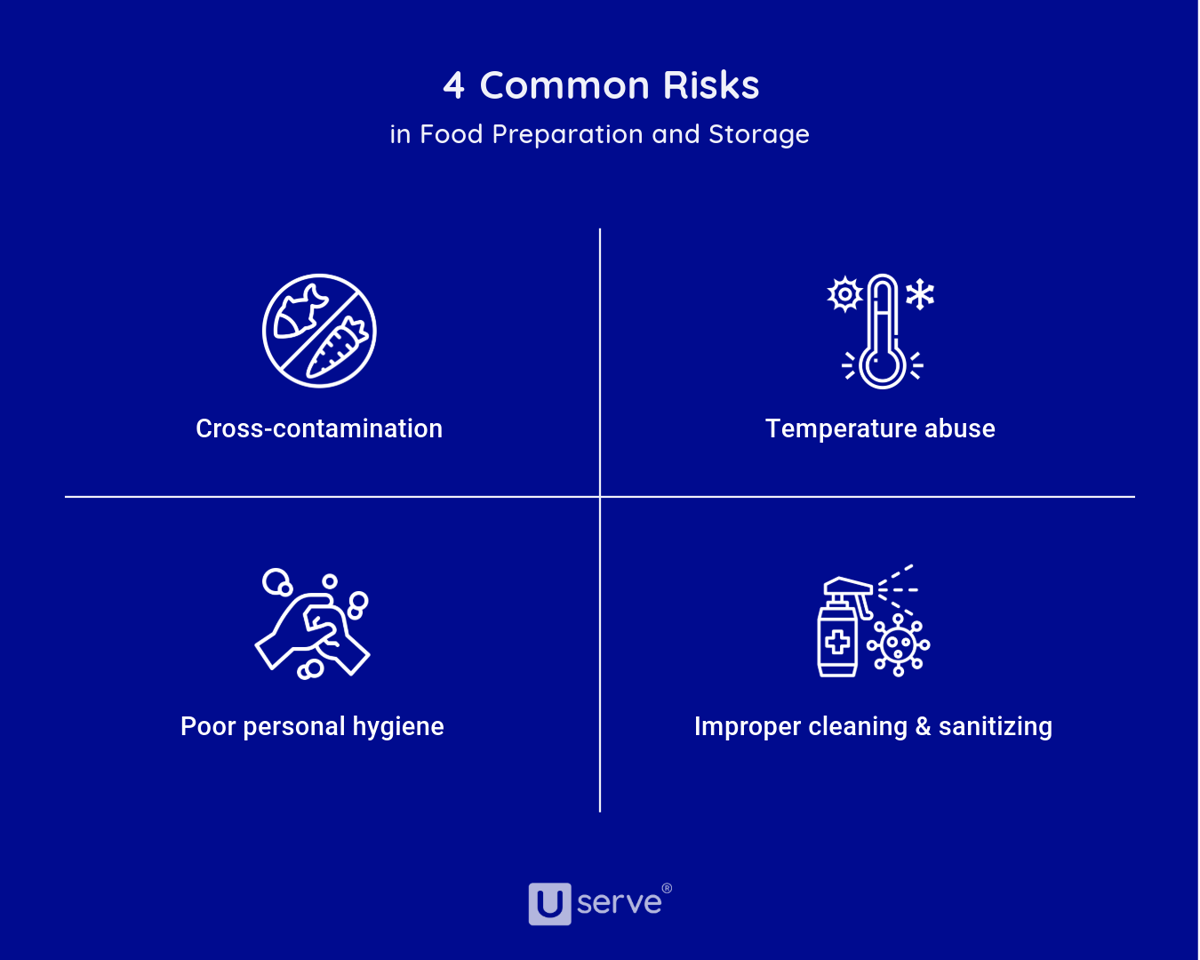In the world of food service, safety is paramount. Food Protection Managers play a crucial role in ensuring that every meal served is safe to eat by identifying and mitigating risks associated with food preparation and storage.
This blog will explore the food safety risks faced by food businesses and the solutions a manager can provide based on their Food Protection Manager training.
How Do Food Protection Managers Contribute to Food Safety?
A Food Protection Manager is responsible for overseeing the safety and quality of food in a dining establishment. Their duties include monitoring food preparation processes, enforcing food safety regulations, and training staff. The eight activities below are fundamental for Food Protection Managers looking to fulfill their obligation of ensuring safety and quality throughout their business:
1. Compliance and Record Keeping
- Maintain records of food safety audits, inspections and corrective actions.
- Ensure compliance with local, state and federal food safety regulations.
- Handle documentation required for food safety certification and inspections.
2. Crisis Management
- Develop and implement procedures for handling food safety emergencies.
- Conduct investigations in case of foodborne illness outbreaks or contamination incidents.
- Communicate with health authorities and follow up on corrective actions.
3. Customer Safety and Education
- Provide information and education to customers about food safety practices.
- Address customer concerns and complaints related to food safety.
- Promote a culture of food safety within the establishment.
4. Food Handling and Storage
- Ensure proper storage of food products to prevent contamination and spoilage.
- Monitor temperatures of refrigerators, freezers and other storage areas to ensure they are kept within a suitable range.
- Implement procedures for receiving and inspecting food supplies.
5. Food Safety Management
- Develop and implement food safety policies and procedures.
- Monitor and ensure compliance with food safety regulations and standards.
- Conduct regular inspections of food preparation and storage areas.
6. HACCP Implementation
- Develop and maintain Hazard Analysis and Critical Control Points (HACCP) plans.
- Identify potential food safety hazards and implement control measures.
- Monitor critical control points and maintain documentation.
7. Hygiene, Cleaning and Sanitizing
- Ensure that food preparation facilities are clean and sanitized.
- Monitor pest control measures and address any pest-related issues.
- Oversee the proper maintenance, cleaning and sanitization of equipment and facilities.
8. Training and Supervision
- Train staff on proper food handling, storage and sanitation practices.
- Supervise food handlers to ensure they follow safety protocols.
- Keep records of training sessions and certifications.
By performing the tasks listed above, a Food Protection Manager can help ensure that all food served by their establishment is safe to eat, preventing foodborne illnesses and allergic reactions in the process.
Common Risks in Food Preparation and Storage
Food safety risks can arise at any point in the food handling process, from procurement to serving. Understanding these risks is essential for effective management.

Cross-Contamination
Cross-contamination occurs when harmful bacteria are transferred from one surface or food to another. This can happen through direct contact, such as raw meat touching ready-to-eat foods, or indirectly through contaminated utensils or hands.
Improper Storage
Improper storage of food can lead to the growth of harmful bacteria. As a result, foods need to be stored at the correct temperatures to prevent spoilage. For example, perishable items must be kept at temperatures below 40°F, while hot foods should be held above 140°F.
Inadequate Cooking
Failing to cook food to the proper temperature can result in the survival of harmful pathogens. Each type of food has a recommended internal temperature that must be reached to ensure safety. For instance, ground beef should be cooked to at least 160°F.
Poor Personal Hygiene
Staff must maintain a high level of personal hygiene in line with the standards described in Userve’s Food Handler Training program. This includes regular handwashing, wearing clean uniforms, and avoiding work when ill.
Identifying and Mitigating Risks
Food Protection Managers use a variety of methodologies to identify and mitigate risks, as outlined in the examples above, to ensure that the dining experience remains safe.
Conducting Regular Inspections
Regular inspections are a fundamental part of a Food Protection Manager's duties. These inspections help identify potential hazards and ensure that safety protocols are being followed. Inspections cover everything from checking the cleanliness of kitchen surfaces to ensuring food is stored at the correct temperatures.
Implementing a HACCP Plan
Hazard Analysis Critical Control Points (HACCP) is a systematic approach to food safety that focuses on preventing contamination before it occurs. A HACCP Plan identifies potential hazards at each stage of the food handling process and establishes critical control points where risks can be mitigated.
HACCP principles:
- Conduct a Hazard Analysis
- Identify Critical Control Points
- Establish Critical Limits
- Monitor Critical Control Points
- Establish Corrective Actions
- Establish Record Keeping
- Establish Verification Procedures
Training and Education
Continuous training is vital for maintaining high food safety standards. A comprehensive Food Protection Manager Course covers all aspects of food safety, from understanding microbiological hazards to implementing effective sanitation practices. Ongoing education ensures that staff stay updated on the latest food safety regulations and best practices.
Monitoring and Documentation
Effective food safety management requires diligent monitoring and documentation, with Food Protection Managers keeping detailed records of inspections, training sessions, and corrective actions taken. This documentation helps track progress, identify recurring issues, and ensure compliance with regulatory standards.
Utilizing Technology
Modern technology provides valuable tools for food safety management. Digital thermometers, for instance, offer accurate temperature readings, while food safety software can streamline documentation and track compliance. Leveraging these tools helps Food Protection Managers maintain high standards of safety and efficiency.
The Impact of Food Protection Manager Training
Proper training is essential for effective food safety management. A well-trained Food Protection Manager can significantly reduce the risk of foodborne illnesses and protect the reputation of their establishment.
Userve’s online Food Protection Manager Course covers the following topics:
- Food Protection Manager Roles and Responsibilities
- Food Safety Regulations
- Biological Contamination
- Physical Contamination
- Chemical Contamination
- Cross-Contamination
- Foodborne Illnesses
- Food Allergies
- Personal Hygiene
- Cleaning and Sanitizing
- Developing a Food Safety Plan
- Facility Design and Equipment Maintenance
- Emergency Preparedness and Response
- Supplier Selection and Receiving Deliveries
- Food Storage and Preservation
- Pest Control
Food Protection Manager Training not only helps safeguard public health but also enhances the reputation of dining establishments.
Ready to meet your legal obligations and contribute a safer dining experience? Enroll in Userve’s ANAB-CFP Accredited Food Protection Manager Program today and take the first step towards becoming a certified Food Protection Manager.

